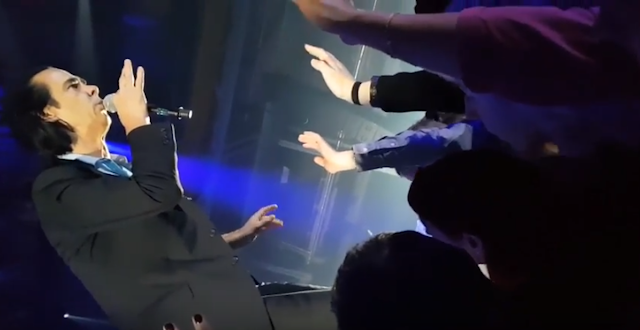It’s October 2017 and a crowd has filled the Royal Arena in Copenhagen for a performance by Nick Cave and the Bad Seeds. Fans crowded at the edge of the stage applaud feverishly when Cave appears. The singer has the microphone in his right hand and gestures with the left. Standing almost directly above the audience, his hands hover over spectators’ heads, inviting them to reach out to him – his body almost touches them. And when he sings “Can you feel my heart beat?”, Cave grasps spectators’ hands and brings them to his chest. After a brief moment of puzzlement, the audience responds, offering him their hands.
This is not just another rock concert. This is the band’s first concert tour after the loss of Cave’s 15-year-old son Arthur, who died in July 2015. The audience is well aware of the traumatic effect on Cave – he shared this in the 2016 film One More Time With Feeling.
You change from a known person to an unknown person. So that when you look at yourself in the mirror, you recognise the person that you were, but the person inside the skin is a different person.
On stage, Cave’s hands run the show – the hands that hold the microphone and give it to spectators to hold while he rhythmically claps. The hands that play the piano, that touch, grab, grasp, hold spectators’ hands. The hands that grab towels to wipe his sweat, the hands that hug a young spectator. The hands that the audience hold so tight, as if they are helping to keep him on his feet, to keep going.

But how about the others that Cave cannot physically touch? The Royal Arena has a capacity of 12,500 people. How can someone – like myself – seated among 20,000 spectators near the back row of the O2 Arena in London a few days before the Copenhagen concert, get touched by this? But I did. And I felt that touch again just recently, while sitting in a movie theatre watching a recording of the Copenhagen concert in the film Distant Sky.
I could hear Cave’s voice. I could see his body and the handclasps. I could see others hearing and seeing him. And I held and was held by the performer’s and spectators’ hands. Magic?
Communication and empathy
Touch is remarkable in the way it connects. According to the French philosopher Maurice Merleau-Ponty (1908-1961), when my two hands clasp each other, or one of my hands clasps yours, both hands are touching and are touched and they establish a connection between them, between us. But who is touching who – and who is holding who? Me or you, Cave or his spectators? This is mutual communication without words. I reach out to you and I take the risk that you may withdraw your hand, refuse touch, refuse connection.
When Cave sings “With my voice I am calling you’, he invites spectators to touch his hand, when he demands "Look at me now!” he grasps their hands. While the body of the singer sings of his need for connection, spectators touch by seeing and hearing. According to Merleau-Ponty, touch is a model sense and different senses interrelate like “hands” – they “touch” each other and through their interweaving, they allow people to connect.
Influenced by Merleau-Ponty, in the 1990s, the Italian neurophysiologist Giacomo Rizzolatti discovered mirror neurons, which are activated both when we see and when we act. He conducted experiments showing that empathy is possible because when we see a gesture being performed, it is as if we are doing it ourselves. In this way, touch can “touch” other people.
Intense emotion
The effect of Cave’s handclasp with one person is amplified through seeing and hearing – and the intensity of their connection explodes in the huge concert venues making them “smoking, boiling, melting, burning” – to quote the words stencilled on his concert piano. We experienced the same intensity sitting in our seats in the movie theatre. When the camera switches from close-ups or medium shots of the first rows to long shots of the Royal Arena, the audience exploded just as if they were in the venue itself.
When Cave sings “I need you” and his body and voice crack, the audience sees the trauma of his son’s death. He transforms the music into “a weeping song” – but it isn’t for his son alone. We respond because we all have a precious person, that – in Cave’s words from his song Girl in Amber – we wish that “no part of her go unremembered”. Together we are a strong body of hearing, seeing and touching that makes an event of togetherness happen. In the end, when we “push the sky away” with our raised arms, we also push grief away, we are filled with delight and gratitude.
In his live performance documented in the film Distant Sky, Cave has revealed the power of the familiar – more often than not underrated – format of the rock concert, through the unexpected element of touch that “gets you right down to your soul”.

